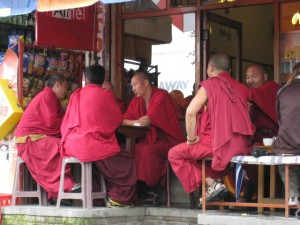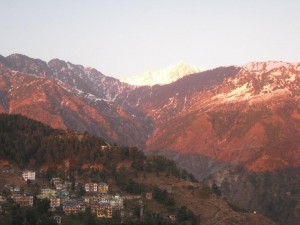Monday
Featured StoriesThe “Technology” of Flexibility
by Sara Lewis, PhD, LMSW, New York City
Stopping at a tea stall on the side of the road to drink a glass of peppery Indian chai, Tashi Lhamo squints back at me. “These problems you always want to discuss,” she teased, holding my hand, “it’s better not to get too caught up with the problems in your life. Don’t pay them any mind. Instead, we should try to have sems pa chen po (big or vast mind) and not focus on problems.”
Like many of the Tibetan refugees I interviewed during 14 months of fieldwork in Dharamsala, India, Tashi Lhamo, although very open, was reticent to discuss specific details of hardship and difficulties in her life, claiming that others’ had it much worse than she. Despite spending 8 months in a Chinese prison, she does not consider herself a political refugee. “Ex-political prisoners, these are people who suffered very badly,” she explains. “When difficult things happen in life, we should just to do our best and move on. Or we can become very upset and make things even worse.” While difficult, many Tibetan refugees note that the most resilient people remain calm on the inside, no matter what is happening on the outside.
Certainly not all Tibetans are resilient in the face of violence and displacement; many continue to suffer greatly in the wake of difficult life events. But how do everyday people manage? I found that regardless of religiosity, many Tibetans explained how important it is to craft a more “flexible mind” in times of stress and adversity. The concept of “flexibility” is a method or a technology for cultivating an inner environment of stability.
Generating flexibility within the mind takes many forms. In this culture, compassion is a particularly important “technology” used to work on the self, particularly in times of crisis. Techniques such as thinking of all the others in the world who are experiencing similar (or worse) problems, and wishing happiness for all sentient beings are skillful ways of working with distress.
Cultivating an attitude of flexibility is markedly different from repressing or denying emotions. Rather, a flexible attitude involves seeing a situation from a variety of perspectives and holding interpretation and reactions somewhat lightly. From the Tibetan perspective, emotions, time, memories, and even the coherence of the self are impermanent and changing moment-by-moment. When we resist and refuse to accept this metaphysical reality, we experience tremendous suffering. Therefore, solidifying traumatic narrative only keeps us stuck in illusion. At the same time, past events have very real consequences through karma and rebirth. The history of experience is not merely a personal story but a long project of being in the world that predates one’s birth and extends on beyond death to future lives.
But how do everyday, regular people in the Tibetan exile community relate with such seemingly esoteric metaphysical concepts? To appreciate the illusory nature of self and also function in the world, the logic of flexibility becomes a highly adaptive practice — particularly in managing traumatic memory. Flexibility in this context refers to the capacity to avoid clinging or holding too tightly to anything — including suffering. And although it might seem counterintuitive why anyone would hold onto suffering, as one lama explained to me: “even though we may be miserable, having big and very important problems gives us the feeling that we, ourselves, are big and important. Most people prefer that to seeing clearly that emotions and fixations are not such a big deal.” It is recognized that solidifying and holding tightly to negative experiences only makes things worse.
It is recognized that events from the past do play an intimate role in the present and future (specifically in terms of karma). But engaging with the content and solidifying descriptions of the past, or narratives, are not seen as particularly skillful ways of managing the difficult emotions associated with traumatic events.
 The stance of flexibility appreciates a certain kind of paradox. I recently heard a presentation given by Richard Davidson, a neuroscientist at the University of Wisconsin-Madison. Davidson has worked on meditation and the brain for decades, and knows the Dalai Lama quite well. He described how sometimes the Dalai Lama will burst into tears when hearing about a sad event. And then in the next moment, he is laughing and joking. Davidson says it is quite remarkable to witness someone who is so fully present, and at the same time, his emotional states are never fixed. Indeed, one interesting finding in studies investigating the effects of meditation on the brain shows that people who learn to meditate will recover from negative emotions faster than control groups. There seem to be no significant differences in how often meditators versus non-meditators experience negative emotions, but there are significant differences in how long they last.
The stance of flexibility appreciates a certain kind of paradox. I recently heard a presentation given by Richard Davidson, a neuroscientist at the University of Wisconsin-Madison. Davidson has worked on meditation and the brain for decades, and knows the Dalai Lama quite well. He described how sometimes the Dalai Lama will burst into tears when hearing about a sad event. And then in the next moment, he is laughing and joking. Davidson says it is quite remarkable to witness someone who is so fully present, and at the same time, his emotional states are never fixed. Indeed, one interesting finding in studies investigating the effects of meditation on the brain shows that people who learn to meditate will recover from negative emotions faster than control groups. There seem to be no significant differences in how often meditators versus non-meditators experience negative emotions, but there are significant differences in how long they last.
In my study, when asked to identify the characteristics of a resilient person, Tibetans described someone who is compassionate, humble (does not exaggerate their problems), and has a flexible, vast and spacious mind, what might be called “big mind” (sems pa chen po). To cultivate this flexibility, instead of resisting the situation, one works to transform one’s relationship to what is happening, even in the face of severe outer and inner chaos. Consider the following narrative from a monk:
“I was arrested in 1988. Those in prison have great suffering because they have no freedom and are put in small cells. Many masters of the past made great efforts to become bodhisattvas despite many hardships. When I think of this, I didn’t feel my suffering in prison was very great. I had to stay as a prisoner, but I just thought of it as a retreat house. If we have too much food we feel sleepy; since I had only had a little food, actually this was much better for practice! I was there for one year and was able to recite 100,000 mantras each of Guru Rinpoche and Chenrezig. There were many monks there like me, using it positively as an opportunity to practice. Some said: ‘since we are monks, if we have to stay our whole lives here and die in prison then it is not really prison because we are here practicing the Dharma.’ It is good to have all this suffering now in this life because then it is purified and we won’t experience much later.”
This passage foregrounds a number of coping strategies. He acknowledges, “I have to be here anyway,” so he tries to accept the situation and transform his mind to think more broadly. During my time in Dharamsala I often heard people recite the Dalai Lama’s, perhaps, favorite piece of advice: “If you can’t change the situation, why worry? And if you can change the situation, why worry?” The monk does not deny pain and hardship. Yet he changes his attitude or the way he relates to the situation, using his time in prison as a retreat house.
While at first glance, stories such as these may seem like internalized oppression, or merely accepting one’s fate. The difference seems to be the location of agency and exercise of reflection. With enough space in the mind to accommodate such thinking, one maintains his or her power even in unthinkable situations.
~~
 Sara Lewis is an anthropologist of religion and healing with a geographic focus on Tibet and the Himalayas. She recently completed her PhD at Columbia University. Sara has been a member of the Shambhala community since 2005 and is also a student of Dzongsar Khyentse Rinpoche. She serves as the New York City center Desung and is a member of the local governing council. Visit saraelewis.wordpress.com to learn more about Sara’s research.
Sara Lewis is an anthropologist of religion and healing with a geographic focus on Tibet and the Himalayas. She recently completed her PhD at Columbia University. Sara has been a member of the Shambhala community since 2005 and is also a student of Dzongsar Khyentse Rinpoche. She serves as the New York City center Desung and is a member of the local governing council. Visit saraelewis.wordpress.com to learn more about Sara’s research.






May 12, 2014
Reply
Very interesting, thanks!
May 11, 2014
Reply
Sara
Thank you sharing this wisdom. It was timely for me to hear that I don’t have to attend to my pains in the ways that I usually do. I like this flexibility of view and will remember it. And you.
joel
May 6, 2014
Reply
Great article,Sara.
It would be interesting to really get into a step by step comparison of approaches to trauma and their outcomes.
Keep up this exploration…it is really valuable.
Judy
May 5, 2014
Reply
Thanks Sara, An interesting contrast to the typical American reaction to difficulties which seems to be to “fight” the situation, toughen up, and to solidify.. whether it is disease, trauma etc..
May 5, 2014
Reply
Great article! Thank you! It’s always good to remember Big Mind! + No Big Deal! They are co-emergent!